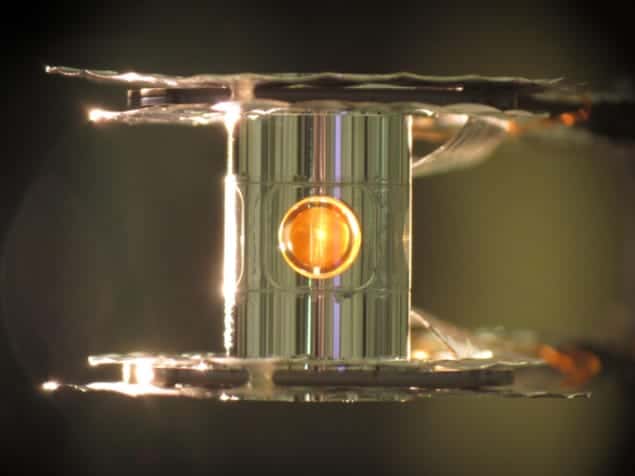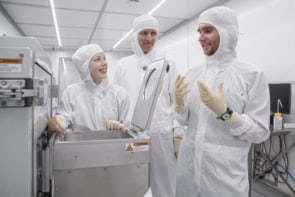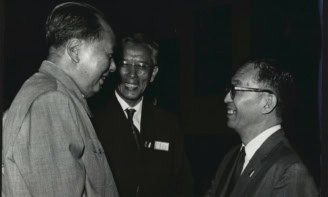
Scientists at the Lawrence Livermore National Laboratory (LLNL) in California have achieved a “fuel gain” of greater than one at the National Ignition Facility (NIF). Using NIF’s ultra-powerful laser to crush tiny pellets of deuterium–tritium fuel, they have produced more energy from fusion reactions than was deposited in the fuel. Although still far from the long-sought-after goal of “ignition”, the latest results are nevertheless an important step on the road to realizing fusion energy, say researchers.
NIF was completed in 2009 at a cost of $3.5bn and uses 192 laser beams to deliver 1.8 MJ of energy to a tiny target over a period of just a few billionths of a second. The target consists of a hollow gold cylinder a centimetre long, known as a hohlraum. At its centre sits a peppercorn-sized sphere of frozen deuterium and tritium encased inside a plastic shell. Laser pulses heat the inside of the hohlraum thereby generating X-rays that rapidly remove or “ablate” material from the outside of the shell, so causing the fuel to implode. This implosion creates a shock wave that heats up the fuel to temperatures of about 50 million degrees Celsius, causing the nuclei to overcome their mutual repulsion and fuse, producing alpha particles (helium nuclei) and neutrons.
Between 2009 and 2012, researchers at NIF worked on a project designed explicitly to achieve ignition, the point at which heat provided by alpha particles increases the rate of fusion reactions such that they release more energy than is supplied by the laser. However, that work proved to be disappointing, leading to energy outputs about 1000 times smaller than the input. After scrutiny by Congress, the National Nuclear Security Administration, which oversees NIF, announced a new, more deliberative strategy designed to work out what went wrong. The strategy also emphasized the importance of alternative approaches to “inertial-confinement fusion”, such as “fast ignition” and “Z-pinch”.
On new footing
In the latest work, Omar Hurricane and colleagues at the LLNL have upped NIF’s output by changing the shape of the facility’s laser pulses. Previously, the pulses were of the “low-foot” variety, which means that the X-ray energy delivered to the target remained relatively low for most of the pulse duration before rapidly increasing. The idea was to compress the fuel to the highest possible densities to maximize fusion reactions. Unfortunately, however, this approach caused the plastic shell surrounding the fuel to break up, so reducing the pressure inside the fuel and limiting the output energy.
The laser pulses in more recent “high-foot” experiments were instead shaped to supply more energy earlier on in the compression process. This allows more heat to be delivered to the fuel before it has had a chance to compress significantly. This limits the total compression that can be achieved because more work needs to be done on the fuel to achieve a certain density, just as a tyre becomes harder to squeeze when it is pumped up using hot air. However, the virtue of this approach is that it yields a much more stable implosion. Indeed, by limiting their ambition, the researchers have managed to get more energy out of the fuel.
In a paper published in Nature, Hurricane and colleagues report results from experiments carried out last September and November – the former producing 14 kJ of fusion energy from a single laser shot and the latter 17 kJ. The researchers point out that since the energy delivered to the fuel is about 10 kJ, both shots generated a fuel gain. They also calculated that as much as half of the energy output from these shots originated in alpha-particle heating. This is significant because such heating is a prerequisite for ignition.
Agreement with computer models
Team member Paul Springer adds that a more recent shot, carried out after the team had submitted its paper, generated about 26 kJ of energy, most of which the researchers believe came from alpha-particle heating. Another plus point from the latest work, says Springer, is the fact that the results are similar to predictions from computer simulations. A close match between experiment and modelling, he notes, is particularly important if NIF is to fulfil its number-one objective: helping to maintain the US’s stockpile of nuclear weapons without testing.
Robert McCrory, director of the Laboratory for Laser Energetics at the University of Rochester in upstate New York, sounds a cautious note, however. Like other researchers working on fusion, he says it is not yet clear whether NIF will be able to achieve ignition, arguing that “the latest results are probably about as far as this high-foot approach can be pushed”. While he “applauds the current result”, he adds that “we must wait and see if we can achieve the understanding required to not only get ignition, but robust reliable gain from a fusion target”.
Indeed, the NIF researchers recognize that uncertainties lie ahead. Group member Denise Hinkel cites an analogy between the quest for ignition and climbing cloud-covered Mount Kilimanjaro in Tanzania. “As you go up, you know that you are getting closer to the summit,” she says, “but you don’t know how close. That is also true with ignition.”
Steep climb to ignition
Although the researchers have demonstrated fuel gain, it needs to be further increased by about a factor of 100 to achieve ignition. Springer points out that most of the energy from the laser in fact goes in heating up the hohlraum and the plastic shell. He and his colleagues are now studying hohlraums that generate more spherically symmetrical, and therefore more efficient implosions, as well as improved shell materials. “The less plastic you use, the faster the fuel will implode,” he explains. “But you have to have some plastic because otherwise you will ablate the fuel. There is a balance to be struck and we haven’t struck it yet.”
Steve Cowley, director of the Culham Centre for Fusion Energy in the UK, points out that the rival “magnetic-confinement” approach to fusion that will be studied in the ITER project under construction in France has already approached energy breakeven. Indeed, in 1997, Culham’s JET reactor had already generated 16 MW of power from an input of 24 MW. But he believes that both approaches to fusion energy must be pursued. Arguing that the research by Hurricane and colleagues “begins to get at the core problems that NIF has”, he says that “we have waited 60 years to get close to controlled fusion. We are now close in both magnetic- and inertial-confinement research. We must keep at it.”


